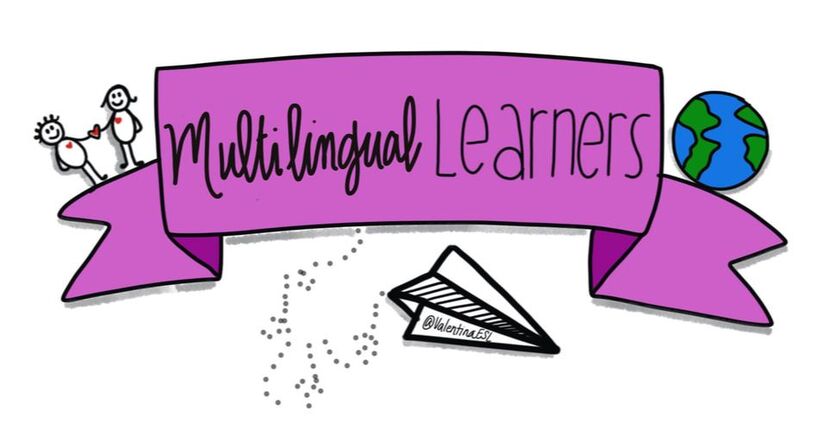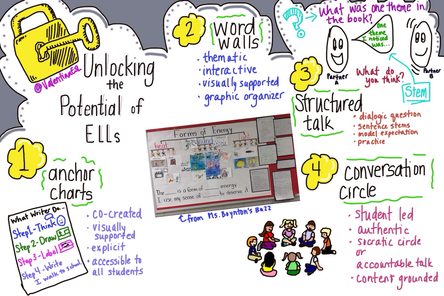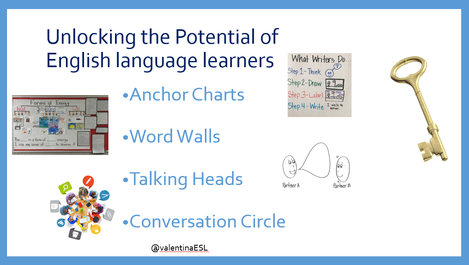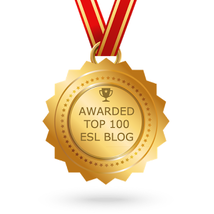|
There are many ways to unlock the potential of our English language learners (ELLs). In this post, I will share with you my favorite 4 instructional techniques. These are the KEYS to unlocking the potential of all students. At first glance, you may say, "I do all of these." But take a close look. Examine how to maximize these 4 techniques so they create an environment where all students THRIVE! 1. Anchor Charts
Okay, okay...every classroom has them. Yes, that's true. BUT let's stop to consider the anchor charts on the walls. Who are they accessible to? Is the language accessible to the struggling student who will need it while the teacher is working with a small group? Is it accessible to the ELL who might need extra support during independent work? If the answer is no, then the anchor must go! A few rules to live by with anchor charts: -they should be highly visual. Use pictures of graphics as often as possible. -cocreate them with students so they can take ownership of the learning. -place them in a highly visible location There are 2 main types of anchor charts: content and process. Content anchor charts teach about a certain topic. For example a chart on the parts of a book, the water cycle, types of polygons, etc. Process anchor charts teach the steps to do something. For example how to write more about a topic, how to add 2 digit numbers, how to complete a lab, etc. The problem is that most of the anchor charts in our classrooms are currently content anchor charts, so when kids are working independently and they get stuck they have trouble because the anchor chart doesn't help them move past the problem. We need more of a balance in anchor charts. In my district, we can't have too much paper or anything on our walls (the fire marshal frowns on it). So what I do is take a picture of my anchor chart before I take it down and I print off 6 to a page (I prefer color but I know that's a challenge). And I give the small anchor chart pictures to my ELLs and students who might need them for future reference. They glue them into the corresponding journal-reading, writing, math, etc. 2. Word Walls I had a word wall in my classroom too. But it was horrible now that I think back on it. It was an alphabetic word wall that I spent hours creating. I wrote the words. I put them up on the wall and the only kids who used the wall were the ones who could read and write in English. I eliminated a large portion of my students. Now that I know better, I do better! Interactive word walls are giant graphic organizers that are created with the class. They are highly visual with pictures and real objects and are unit or theme based. Kids love them, and better yet, they learn from them! 3. Structured Talk Student talk is one of the first things to get dumped when we feel the curriculum crunch. Talk isn't graded so often as teachers we let that go. HUGE mistake! Kids need to talk if they are going to internalize what we want them to learn. The mere fact that we stand up in front of a room of kids and deliver instruction does not mean that they will learn anything. Sadly, research says that ELLs spend less than 2% of their school day talking in the classroom. That's alarming. And when I think of our ELLs, I know that many of them go home and speak in their native languages. Which is AWESOME! We want them to do that. But when they are in our care, in our school building, in our classrooms, we NEED them to learn how to communicate effectively. And we can't expect them to know how to do that without scaffolds and explicit instruction. Two of my favorite structured talk techniques are: -Talking Heads -QSSSA click on the links to learn more about them. 4. Conversation Circle The highest form of talk in the classroom is the conversation circle, sometimes called accountable talk or Socratic circle. This form of talk in the classroom is student led and authentic. When students have had plenty of support and scaffolding to hold conversations with partners, they can advance further into a less structured talk with a group. This kind of talk resembles the talk you might have with a close friend or colleague about something you are passionate for such as education or politics. The conversation flows, meanders, and is reciprocal. You come in to the conversation one way and leave feeling changed in a sense. In the classroom, a conversation circle starts with a the teacher posing a dialogic question to the group that is sitting in a circle. A dialogic question is a question that promotes dialogue or may have more than one answer as opposed to a monologic question that would only have one answer. Here are a couple of examples: dialogic: What surprised you? monologic: What was the setting of the story? After the teacher poses the first question, the students continue the conversation and the teacher steps back only to facilitate. This is the hardest part because the students will try to bring the teacher in by looking at the teacher or even asking the teacher questions. Be resistant and let them take over. I like to post discussion starters which are sentence stems that they can use if they get stuck. They don't have to use them but they are available just in case. So in essence, if the environment, the walls are created together and are accessible to students and if students are talking about their learning, we can UNLOCK the potential of our ELLs. And yes, we may all have anchor charts, word walls, and talk in the classroom, but let's reflect on who these supports are accessible to and make them accessible to everyone! These are just 4 ways to begin unlocking the potential, but what a great start!
Cindy Ip
8/3/2017 10:52:52 pm
These are great strategies! My next goal is to improve the level of talk in my room and I look forward to learning more about Talking Heads and QSSSA.
Valentina
8/8/2017 08:38:07 pm
Thank you very much!
Valentina
8/7/2017 10:06:25 pm
Hi Natalie, Comments are closed.
|
Categories
All
|



 RSS Feed
RSS Feed
